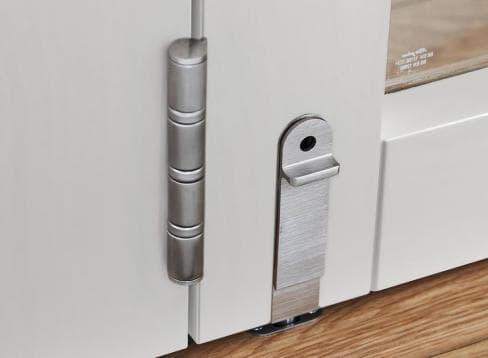TOP-HUNG OR BOTTOM-ROLLING—WHAT IS THE DIFFERENCE?
All internal sliding doors require a main track to operate. However, whether this track is top-hung or bottom-rolling varies across door manufacturers, and each location has its own benefits and considerations.
What is a top-hung track?
Top-hung bifold doors ‘hang’ from the main track which is located in the frame head. The rollers are attached to a hinge which is in turn fixed to the top of the access and middle door. The roller is enclosed in the main track so it is impossible for the doors to come out of the track during operation. The bottom track is used as a guide only (if at all).
|
PROS
|
CONS
|
|
Lower threshold— the main rolling hardware sits in the frame head above the door. The guide track is therefore at the bottom, with a slimmer profile than the main track. This results in the threshold also being lower, making it easy to install flush with the floor, which not only stops people tripping over but looks better as well.
|
Installation— when fitting top-hung bifold doors, the main track must be securely fastened over the full length of the door set. You will need to drill holes upwards into the supporting lintel which can be awkward.
|
|
Smooth operation— with top-hung bifolds, the door's weight hangs from the top, which means they require less force to move along the track. You can literally push them with your fingertip.
|
|
|
Low-maintenance— dirt and debris is unlikely to collect in an upper track, meaning the tracks will require less cleaning and maintenance.
|
|
|
Keeps doors secured— with top-hung tracks, the doors cannot fall out of the track, which means they offer an added layer of safety.
|
|
WHAT IS A BOTTOM-ROLLING TRACK?
Bottom-rolling bifold doors are the opposite of top-hung. All of the door’s weight is carried on the floor. The main track is located in the bottom threshold of the frame. The rollers are attached to a hinge that is fixed to the bottom of the access and middle door.
On a bottom-rolling system, the guide track is located in the frame head. This prevents the doors from falling outwards when the doors are open.
Aluminium doors are almost always bottom-rolling. This is because they are designed to be used as external doors and are heavier due to double glazing, etc., which is considered unnecessary for internal doors.
|
PROS
|
CONS
|
|
Installation— fewer holes are needed in the guide track located in the frame head.
|
Jamming/blockages— because the main track is based on the lower part of the door set, small items and debris can fall in and block/damage the roller, causing your doors to jam.
|
|
Requires less support— heavy top-hung door systems usually require a lintel for the doors to hang from. Bottom rolling systems need less support as the weight is carried on the floor. However, internal doors are light enough to require minimal support to use a top-hung track.
|
Track dipping— if the main bottom track isn’t perfectly level and/or is poorly supported, the track can start to dip. This stops the doors from operating smoothly and can allow the doors to fall out of the top guide track if the dip is large enough.
|
|
|
More maintenance— you will need to regularly clean the bottom track to keep the doors operating smoothly.
|
|
|
Higher threshold— as the main track is generally larger than the guide track, bottom roller systems usually have a higher threshold at the bottom of the door set. This can be a trip hazard and while not impossible, it’s much harder to install flush with final floor levels.
|
DO INTERNAL BIFOLD DOORS NEED A TRACK?
Yes, all bifolds need some form of track system as these are what guide the door rollers. However, some door companies refer to their products as ‘trackless’ folding door systems. Trackless systems always use a top-hung system and do not need any bottom guide track running across the floor of the room.
WHAT ARE TRACKLESS BIFOLD DOORS?
Trackless bifold doors have no bottom guide track. If you choose top-hung bifold doors, you don’t need to use a bottom track. If you choose this option, your flooring can run seamlessly through both rooms to increase the feeling of one large space when the doors are open. However, if you do install a bottom track that is flush with the floor, this will add support and give your doors a smoother operation.





